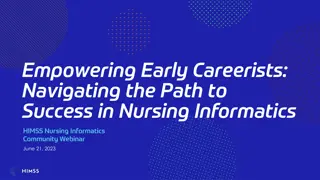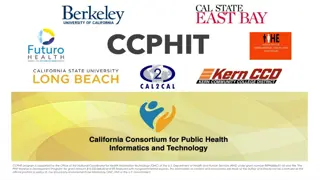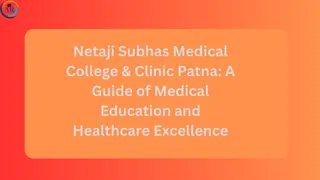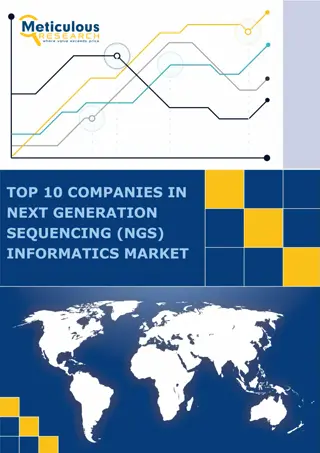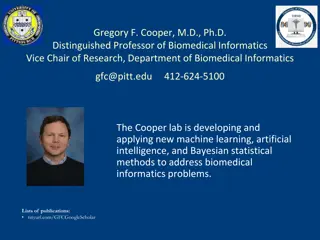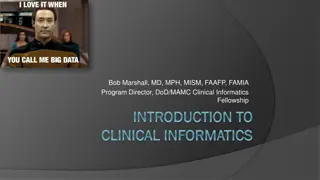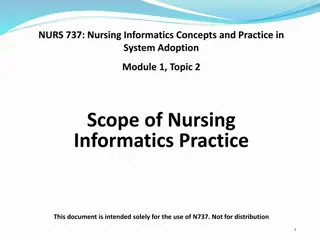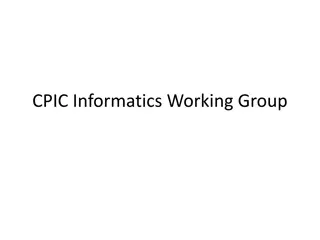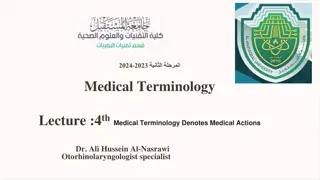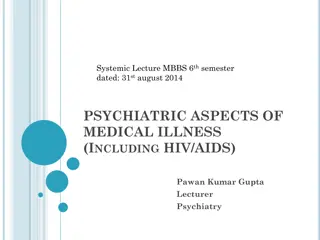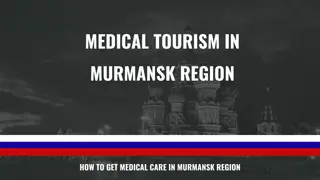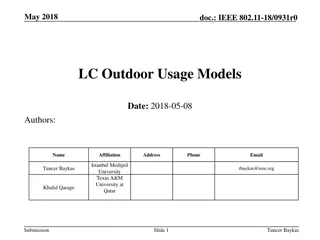
Practical Natural Language Processing for Medical Diagnosis Improvement
"Explore the application of Natural Language Processing (NLP) in radiology interpretation and the impact on diagnosing Community Acquired Pneumonia (CAP). Learn about the challenges, benefits, and real-time screening protocols to enhance early detection and treatment. Discover the importance of NLP in obtaining good diagnostic predictions through radiology interpretations and standardizing terminology."
Download Presentation

Please find below an Image/Link to download the presentation.
The content on the website is provided AS IS for your information and personal use only. It may not be sold, licensed, or shared on other websites without obtaining consent from the author. If you encounter any issues during the download, it is possible that the publisher has removed the file from their server.
You are allowed to download the files provided on this website for personal or commercial use, subject to the condition that they are used lawfully. All files are the property of their respective owners.
The content on the website is provided AS IS for your information and personal use only. It may not be sold, licensed, or shared on other websites without obtaining consent from the author.
E N D
Presentation Transcript
Practical Natural Language Processing Harvesting Low Hanging Fruit Jeffrey P Ferraro, PhD (Jeffrey.Ferraro@imail.org) Scott L DuVall, PhD (Scott.DuVall@hsc.utah.edu)
Outline Application of NLP - involves interpretation of radiographs. Effects on NLP with and without radiology interpretations. Some issues around obtaining good NLP results. Difficult interpretations due to ambiguity in radiographs. What s been easy and what s hard. Alternatives tried to NLP that have failed. Describe some different approaches to NLP. Describe the mechanics of the method used. Working Example
Early Detection Community Acquired Pneumonia (CAP) Significance CAP along with influenza 8th leading cause of death in the United States. ~6 million cases annually / about 500,000 1.1 million hospitalizations annually. Challenges Diagnostic error rate for Pneumonia: 10% - 25% High variability in hospitalization decisions among clinicians (38% - 79% of hospitalizations could not be explained by illness severity. 10.7% treated as outpatients secondarily admitted within 7 day. Early Detection compliance w/Joint Commission (JCAHO) quality accreditation Benefits Reduction in diagnostic errors. Reduction in unnecessary hospital admissions (20 times more costly). Rapid diagnosis and severity assessment for proper care & treatment.
CAP Real-time Screening and eProtocol CAP eProtocol Vitals Predictive Diagnostic Screening Likelihood of Pneumonia +/- Labs Physical Exam Radiological Reports 1) Pleural Effusion IP vs. OP Treatment 2) Multilobe Infiltrates Severe CAP Criteria IP ICU Tretment 3) Cavitary Disease MRSA Risk Factor Treatment Protocol
Real-time Predictive Diagnostic Screening Bayesian Network
NLP Interpretation Effect Average Merit 6951.986 +-26.887 1618.487 +-22.655 1120.249 +-26.959 1078.845 +-11.476 662.104 +-31.555 496.629 +-17.675 489.792 +-15.667 422.224 +-14.469 224.394 +- 9.062 203.584 +- 9.537 Average Rank Attribute 1 +- 0 NLP Finding 2 +- 0 Temperature 3.1 +- 0.3 Heart Rate 3.9 +- 0.3 Chief Complaint 5 +- 0 Age 6.5 +- 0.5 SPO2 6.5 +- 0.5 Respiratory Rate 8 +- 0 WBC 9.1 +- 0.3 Systolic BP 10.3 +- 0.46 Mean BP AUC with/NLP: 0.92 AUC without/NLP: 0.65
Obtaining Good NLP Results Conclusion Radiology interpretations are necessary for good diagnostic prediction. Challenges Reduction in ambiguous language results in better predictive capabilities Standardization of Terminology Radiologists Response Need complete and accurate clinical contexts. Accurate protocol (film) selection
NLP Challenges - Ambiguous Language Possible Pneumonia Clinical History: Cough and dyspnea. Study: PA and lateral chest on Findings: No comparison studies available. Heart is normal in size. Aorta is moderately tortuous. Lung volumes are normal. Minimal airspace disease is identified within the region of medial right middle lobe, seen on frontal and lateral views. This opacity is consistent with focal atelectasis or possibly inflammatory process. No significant edema. No pleural effusion or pneumothorax. Impression: 1. Mild airspace disease in right middle lobe, as above.
NLP Challenges - Ambiguous Language Positive Pneumonia PA and lateral chest radiograph Comparison: None Indication: Fever, cough Findings: The lungs are symmetrically inflated there is obscuration of the cardiac apex on the frontal projection with increased attenuation on the lateral view suggesting subsegmental lingular airspace disease. The diaphragm appears well visualized. Mild calcification noted at the level of the aortic arch. Mild ectasia of the descending thoracic aorta. Mild cardiomegaly. Osseous structures and soft tissues are unremarkable. Impression: 1. Subsegmental airspace disease of the lingula. Recommend a followup erect PA and lateral chest radiograph. 2. Mild cardiomegaly. 3. Mild atherosclerotic disease and ectasia of the thoracic aorta.
NLP Whats Easy and Whats Hard Clinical Findings using NLP +/- Pneumonia Fairly Good (ambiguity / standard terminology) Sen: 0.95, Spec: 0.81, PPV: 0.93, Acc: 0.91 +/- Pleural Effusions Good (succinct language) Sen: 0.93, Spec: 0.97, PPV: 0.84, Acc: 0.96 +/- Cavitary Disease Good (succinct language) Sen: 0.88, Spec: 1.0, PPV: 1.0, Acc: 1.0 Single lobe or Multi-lobe Infiltrates Poor (must be inferred by locations: RLL, RML, RUL, LLL, LUL, Right Lung, Left Lung) Error Propagation Problem Multi-lobe: Sen: 0.78, Spec: 0.65, PPV: 0.58, Acc: 0.70 Single Lobe: Sen: 0.65, Spec: 0.78, PPV: 0.82, Acc: 0.70
NLP Alternatives that Failed Templating <report body> . . . . Pneumonia Quality Assurance ----------------------------------------- Parenchymal opacity c/w pneumonia in the appropriate clinical setting (yes | indeterminate): or No parenchymal opacity to suggest pneumonia. Multilobar or bilateral involvement (yes|no): Cavitation (yes|no): Pleural fluid (yes|no): No Compliance w/Templating Complex cases Proper Protocol (Film) & Clinical Context Workflow / Productivity Impact (Template Selection)
Approaches to NLP Direct Machine Learning (ML) Classification Course Grained Approach bag of words, sentences, n-grams, chunking phrases Supervised Learning Methods (Need to know Truth) - Support Vector Machines - Gaussian Mixture Models - Bayesian Networks - K-Nearest Neighbor - Decision Trees - Random Forests Information Extraction & Rule based Fine Grained Approach extract clinical concept categories (e.g., appliances, state change, locations, clinical findings) IE: Pattern Matching, NER, statistical inference models) Classification (Inference Rules) Information Extraction & Machine Learning Fine Grained Approach extract clinical concept categories (e.g., appliances, state change, locations, clinical findings) IE: Pattern Matching, NER, statistical inference models) Classification (ML: Supervised Learning Methods)
Course Grained Method + / - Pneumonia Machine Learning Approach Random Forest (ensemble of decision trees) Decision Trees from various perspectives (randomly constrain available features) Majority Vote Rules Required Artifacts - Segmenter - decompose document to sentence - Sentence Level Annotation (positive evidence, negative evidence, no information gain) - Statistical Methods (10-fold cross validation, Bootstrapping) - Training and test data sets
Course Grained Method The upper lobes are well aerated and normal . The right lung appears clear . 0 The remainder of the lungs is clear . The right lung and apical portion of the left upper lobe remains clear . Left lung is clear . 0 No other areas of air space opacity are seen to suggest other regions of pneumonia . There is no segmental or lobar consolidation . There is an area of parenchymal lung opacity present in the left lower lobe and pneumonia is questioned . Left lower lobe pneumonia . 1 However , there is an area of patchy parenchymal opacity present posteriorly in the right lower lobe . 1 The appearance of this is suggestive of pneumonia . There is confluent opacification of most of the posterobasal segment of the left lower lobe . Left lower lobe consolidation , consistent with pneumonia . There is complete opacification of the superior segment of the right lower lobe , with air bronchograms . Frontal view gives this consolidated segment a round appearance . Segmental consolidation , consistent with pneumonia . There is confluent opacity in the left base which blurs the diaphragm . Left basilar subsegmental consolidation , consistent with pneumonia . Spondylitic change is noted of the thoracic spine . On the lateral projection this appears to be in the lingula and the lower lobe . Heart size and vascular pattern are within normal limits . 2 Cardiac size is normal . 2 No extraventilatory air is seen . 2 Underlying bilateral severe bullous emphysema is also noted , with marked hyperinflation in the upper lobes . Central pulmonary arterial hypertension is noted . Expansion is within normal limits . 2 Osseous mineralization is diffusely diminished . Thoracic kyphosis is accentuated and there is severe collapse of several mid thoracic vertebrae . 0 0 - ve 0 0 0 1 1 1 + ve 1 1 1 1 1 1 2 2 ~IG 2 2 2 2
Course Grained Method Feature Set (X) upper 1 0 0 1 0 0 right 1 0 0 0 0 0 lingula 0 0 0 0 0 0 size 0 1 0 0 0 0 lateral 0 1 0 0 0 0 lobe 1 0 0 1 0 0 pneumonia air 1 0 0 0 0 0 seen 0 0 1 0 0 0 0 0 1 0 0 0 Truth (Y) 1 1 0 0 2 2
Course Grained Method Example

